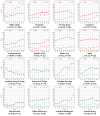Use of Artificial Intelligence, Internet of Things, and Edge Intelligence in Long-Term Care for Older People: Comprehensive Analysis Through Bibliometric, Google Trends, and Content Analysis
- PMID: 40053718
- PMCID: PMC11920668
- DOI: 10.2196/56692
Use of Artificial Intelligence, Internet of Things, and Edge Intelligence in Long-Term Care for Older People: Comprehensive Analysis Through Bibliometric, Google Trends, and Content Analysis
Abstract
Background: The global aging population poses critical challenges for long-term care (LTC), including workforce shortages, escalating health care costs, and increasing demand for high-quality care. Integrating artificial intelligence (AI), the Internet of Things (IoT), and edge intelligence (EI) offers transformative potential to enhance care quality, improve safety, and streamline operations. However, existing research lacks a comprehensive analysis that synthesizes academic trends, public interest, and deeper insights regarding these technologies.
Objective: This study aims to provide a holistic overview of AI, IoT, and EI applications in LTC for older adults through a comprehensive bibliometric analysis, public interest insights from Google Trends, and content analysis of the top-cited research papers.
Methods: Bibliometric analysis was conducted using data from Web of Science, PubMed, and Scopus to identify key themes and trends in the field, while Google Trends was used to assess public interest. A content analysis of the top 1% of most-cited papers provided deeper insights into practical applications.
Results: A total of 6378 papers published between 2014 and 2023 were analyzed. The bibliometric analysis revealed that the United States, China, and Canada are leading contributors, with strong thematic overlaps in areas such as dementia care, machine learning, and wearable health monitoring technologies. High correlations were found between academic and public interest, in key topics such as "long-term care" (τ=0.89, P<.001) and "caregiver" (τ=0.72, P=.004). The content analysis demonstrated that social robots, particularly PARO, significantly improved mood and reduced agitation in patients with dementia. However, limitations, including small sample sizes, short study durations, and a narrow focus on dementia care, were noted.
Conclusions: AI, IoT, and EI collectively form a powerful ecosystem in LTC settings, addressing different aspects of care for older adults. Our study suggests that increased international collaboration and the integration of emerging themes such as "rehabilitation," "stroke," and "mHealth" are necessary to meet the evolving care needs of this population. Additionally, incorporating high-interest keywords such as "machine learning," "smart home," and "caregiver" can enhance discoverability and relevance for both academic and public audiences. Future research should focus on expanding sample sizes, conducting long-term multicenter trials, and exploring broader health conditions beyond dementia, such as frailty and depression.
Keywords: Google Trends; Internet of Things; artificial intelligence; bibliometric analysis; content analysis; edge intelligence; long-term care; older adults.
©Shuo-Chen Chien, Chia-Ming Yen, Yu-Hung Chang, Ying-Erh Chen, Chia-Chun Liu, Yu-Ping Hsiao, Ping-Yen Yang, Hong-Ming Lin, Tsung-En Yang, Xing-Hua Lu, I-Chien Wu, Chih-Cheng Hsu, Hung-Yi Chiou, Ren-Hua Chung. Originally published in the Journal of Medical Internet Research (https://www.jmir.org), 04.03.2025.
Conflict of interest statement
Conflicts of Interest: None declared.
Figures





References
-
- Rahman MM, Rosenberg M, Flores G, Parsell N, Akter S, Alam MA, Rahman MM, Edejer T. A systematic review and meta-analysis of unmet needs for healthcare and long-term care among older people. Health Econ Rev. 2022 Dec 09;12(1):60. doi: 10.1186/s13561-022-00398-4. https://europepmc.org/abstract/MED/36482044 10.1186/s13561-022-00398-4 - DOI - PMC - PubMed
-
- Titley HK, Young S, Savage A, Thorne T, Spiers J, Estabrooks CA. Cracks in the foundation: the experience of care aides in long-term care homes during the COVID-19 pandemic. J Am Geriatr Soc. 2023 Jan;71(1):198–205. doi: 10.1111/jgs.18024. https://europepmc.org/abstract/MED/36082802 - DOI - PMC - PubMed
-
- Thwaites C, McKercher J, Fetherstonhaugh D, Blackberry I, Gilmartin-Thomas J, Taylor N, Bourke Sharon L, Fowler-Davis Sally, Hammond Susan, Morris Meg E. Factors impacting retention of aged care workers: a systematic review. Healthcare (Basel) 2023 Nov 21;11(23):3008. doi: 10.3390/healthcare11233008. https://www.mdpi.com/resolver?pii=healthcare11233008 healthcare11233008 - DOI - PMC - PubMed
-
- Hacking C, Verbeek H, Hamers JPH, Aarts S. Comparing text mining and manual coding methods: analysing interview data on quality of care in long-term care for older adults. PLoS One. 2023;18(11):e0292578. doi: 10.1371/journal.pone.0292578. https://dx.plos.org/10.1371/journal.pone.0292578 PONE-D-23-11158 - DOI - DOI - PMC - PubMed
-
- Rostad HM, Skinner MS, Wentzel-Larsen T, Hellesø R, Sogstad MKR. Modes and models of care delivery in municipal long-term care services: a cross-sectional study from Norway. BMC Health Serv Res. 2023 Jul 31;23(1):813. doi: 10.1186/s12913-023-09750-8. https://bmchealthservres.biomedcentral.com/articles/10.1186/s12913-023-0... 10.1186/s12913-023-09750-8 - DOI - DOI - PMC - PubMed
MeSH terms
LinkOut - more resources
Full Text Sources

